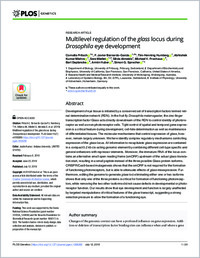Multilevel regulation of the glass locus during Drosophila eye development
- Fritsch, Cornelia Department of Biology, University of Fribourg, Fribourg, Switzerland
- Bernardo-Garcia, F. Javier Department of Biology, University of Fribourg, Fribourg, Switzerland - Department of Biochemistry and Biophysics, University of California, San Francisco, San Francisco, California, USA
- Humberg, Tim-Henning Department of Biology, University of Fribourg, Fribourg, Switzerland
- Mishra, Abhishek Kumar Department of Biology, University of Fribourg, Fribourg, Switzerland
- Miellet, Sara Department of Biology, University of Fribourg, Fribourg, Switzerland - Illawarra Health and Medical Research Institute, University of Wollongong, Wollongong, Australia
- Almeida, Silvia Department of Biology, University of Fribourg, Fribourg, Switzerland
- Frochaux, Michael V. Laboratory of Systems Biology, IBI, SV, EPFL, Lausanne, Switzerland
- Deplancke, Bart Laboratory of Systems Biology, IBI, SV, EPFL, Lausanne, Switzerland
- Huber, Armin Institute of Physiology, University of Hohenheim, Hohenheim, Germany
- Sprecher, Simon G. Department of Biology, University of Fribourg, Fribourg, Switzerland
- 12.07.2019
Published in:
- PLOS Genetics. - 2019, vol. 15, no. 7, p. e1008269
English
Development of eye tissue is initiated by a conserved set of transcription factors termed retinal determination network (RDN). In the fruit fly Drosophila melanogaster, the zinc-finger transcription factor Glass acts directly downstream of the RDN to control identity of photoreceptor as well as non-photoreceptor cells. Tight control of spatial and temporal gene expression is a critical feature during development, cell-fate determination as well as maintenance of differentiated tissues. The molecular mechanisms that control expression of glass, however, remain largely unknown. We here identify complex regulatory mechanisms controlling expression of the glass locus. All information to recapitulate glass expression are contained in a compact 5.2 kb cis-acting genomic element by combining different cell-type specific and general enhancers with repressor elements. Moreover, the immature RNA of the locus contains an alternative small open reading frame (smORF) upstream of the actual glass translation start, resulting in a small peptide instead of the three possible Glass protein isoforms. CRISPR/Cas9-based mutagenesis shows that the smORF is not required for the formation of functioning photoreceptors, but is able to attenuate effects of glass misexpression. Furthermore, editing the genome to generate glass loci eliminating either one or two isoforms shows that only one of the three proteins is critical for formation of functioning photoreceptors, while removing the two other isoforms did not cause defects in developmental or photoreceptor function. Our results show that eye development and function is largely unaffected by targeted manipulations of critical features of the glass transcript, suggesting a strong selection pressure to allow the formation of a functioning eye.
- Faculty
- Faculté des sciences et de médecine
- Department
- Département de Biologie
- Language
-
- English
- Classification
- Biological sciences
- License
-
License undefined
- Identifiers
-
- RERO DOC 327381
- DOI 10.1371/journal.pgen.1008269
- Persistent URL
- https://folia.unifr.ch/unifr/documents/308097
Statistics
Document views: 122
File downloads:
- pdf: 193
